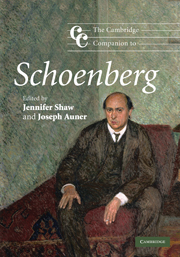Book contents
- Frontmatter
- 1 Introduction
- Part I Schoenberg's early years
- Part II Schoenberg, modernism, and modernity
- 6 Interpreting Erwartung: collaborative process and early reception
- 7 The rise and fall of radical athematicism
- 8 Schoenberg, modernism, and metaphysics
- 9 Pierrot lunaire: persona, voice, and the fabric of allusion
- Part III Schoenberg between the World Wars
- Part IV Schoenberg's American years
- Notes
- Select bibliography
- Index
9 - Pierrot lunaire: persona, voice, and the fabric of allusion
from Part II - Schoenberg, modernism, and modernity
Published online by Cambridge University Press: 28 September 2011
- Frontmatter
- 1 Introduction
- Part I Schoenberg's early years
- Part II Schoenberg, modernism, and modernity
- 6 Interpreting Erwartung: collaborative process and early reception
- 7 The rise and fall of radical athematicism
- 8 Schoenberg, modernism, and metaphysics
- 9 Pierrot lunaire: persona, voice, and the fabric of allusion
- Part III Schoenberg between the World Wars
- Part IV Schoenberg's American years
- Notes
- Select bibliography
- Index
Summary
Since its 1912 composition and premiere, Schoenberg's Dreimal sieben Gedichte aus Albert Girauds Pierrot lunaire (Three Times Seven Poems from Albert Giraud's Pierrot lunaire), Op. 21 has aroused strong responses and extensive commentary, especially regarding its enigmatic approach to Sprechstimme (speaking voice or recitation) and its “atonal” idiom. This chapter, in three parts, synthesizes and extends some themes in the recent critical reception of the work. The first part sketches a history of the Pierrot character in comedy and pantomime, including a description of the genesis and overall shape of Schoenberg's Pierrot lunaire. The second section explores how traditional vocal representations of subjectivity and lyric expression are renatured by Schoenberg's striking approach to Sprechstimme in the work. The final part demonstrates, through selected examples, how the music invokes a rich network of musical allusions, in tandem with tonal latencies that permeate its kaleidoscopic surface.
Pierrots old and new – en blanc et noir
Over the centuries, the Pierrot character has been portrayed by countless actors, pantomimes, and puppets. Originating among Italian commedia dell'arte troupes active in seventeenth-century France, Pierrot first appears in 1660s comedies as a rustic and dumbfounded bumpkin, but in the eighteenth century he became the paragon of pastoral innocence, a pure (and often silent) fool. The nineteenth century gradually transformed him, radically, into a decadent fin-de-siècle dandy, obsessed with the moon. A resemblance with the moon was already suggested by his eighteenth century commedia costume: a powdered white face, soft white hat and large ruffled collar, and loose jacket and trousers of flowing white silk.
- Type
- Chapter
- Information
- The Cambridge Companion to Schoenberg , pp. 120 - 134Publisher: Cambridge University PressPrint publication year: 2010
- 2
- Cited by

